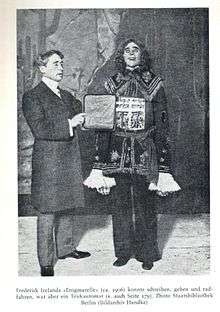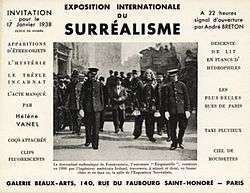Enigmarelle

Enigmarelle was a fake humanoid automaton, in fact with a person concealed inside, which was exhibited as a scientific and technical curiosity around 1905 in the US and Europe, chiefly in theaters. Enigmarelle was claimed to be able to perform several extraordinary tasks, which it demonstrated in performances: these included walking, riding a bicycle, and writing its name on a blackboard.
Presentation
Enigmarelle was shown in the US and then in parts of Europe, in vaudeville theaters and circuses. The booking agent, an American named Frederick J. Ireland, was represented at these appearances as the creator and owner of the automaton.
Enigmarelle was a large automaton and was in fact operated by a human concealed within its body, although the precise operating mechanisms are not known. The operator is believed to have been a performer who had had both his legs amputated and who went by the name of Alba W. Root, and who also performed as a bicycle acrobat using leg prostheses.
Enigmarelle was the subject of a short documentary film in 1905[P 1] and a detailed "scientific" description with three photos in Scientific American in 1906.[C 1] It is mentioned in some modern publications on automatons.[P 2]
Name
The name Enigmarelle seems to be a portmanteau of the French words énigme (enigma) and marelle (hopscotch), but the creators of the machine were English speakers, so there is no reason to suppose a French portmanteau is the true origin of the name.
Known appearances

Documented appearances of Enigmarelle include:
- August 1904: Orpheum Theater, Brooklyn[C 2]
- 1908: Circus Busch, Berlin
- November 1908: Bell Theater, Oakland, California[C 3]
- January 1938: announced exhibition at the Exposition Internationale du Surréalisme, Paris[C 4]
See also
- The Turk, probably the best known fake automaton operated by a human.
External links
- "1904 - Enigmarelle - Alba Root / Frederick Ireland". Cybernetic Zoo. 2010-12-22.
References
Contemporary references
- ↑ "A Clever Mechanical and Electrical Automaton". Scientific American. 94 (2). 1906-01-13.
- ↑ "Enigmarelle, the famous automaton". The Brooklyn Daily Eagle. 1904-08-28.
- ↑ "What is going on at the theaters". Oakland Tribune. 1908-11-15. p. 31.
- ↑ "L'exposition internationale du surréalisme de 1938". Koregos (in French). 2013-12-09.
Modern references
- ↑ Goble, Alan. "Enigmarelle the Wonderful Automaton - Film / Movie". Complete Index To World Film. Retrieved 2016-07-23.
- ↑ Arthur W.J.G. Ord-Hume (1973). Clockwork Music. Australia: Allen & Unwin. p. 334. ISBN 9780047890048.
Another and equally spectacular 'android' was that exhibited at the London Hippodrome in 1905. Called Enigmarelle, this seven-foot high figure possessed incredible abilities. It would walk on to the stage, write its name in somewhat backward-sloping manuscript upon a blackboard, and then ride a bicycle in a circle. Its head was of wax, its feet of steel and its legs of wood and iron. The motive power comprised no less than seven motors-three being spring, and four electric which drew their power from wet-cell batteries concealed in the trunk. Unbuttoning its waistcoat revealed a mass of wheelwork and wires, levers, and cranks. Unfortunately, within all this trumpery there beat no mechanical heart, but that of a real, live man.



